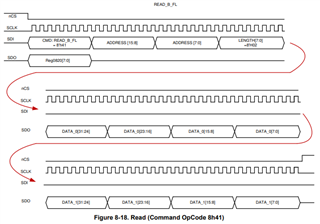Other Parts Discussed in Thread: TCAN4550, TCAN4550-Q1
Hi,
I am trying to interface TCAN4550 to a Linux based processor via SPI. This is my device tree configuration.
&spi1{
pinctrl-names = "default";
pinctrl-0 = <&spi1_pins>;
rtk,spi-for-kernel = <1>;
rtk,spi-slave-mode = <0>; // SPI master
rtk,spi-cs-gpios = <&gpioa 2 0>;
status = "okay";
tcan4x5x: can@0 {
compatible = "ti,tcan4x5x";
reg = <0>;
#address-cells = <1>;
#size-cells = <1>;
spi-max-frequency = <10000000>;
bosch,mram-cfg = <0x0 0 0 32 0 0 1 1>;
interrupt-parent = <&gpioa>;
interrupts = <8 IRQ_TYPE_EDGE_BOTH>;
device-state-gpios = <&gpioa 1 0>;
device-wake-gpios = <&gpioa 6 0>;
reset-gpios = <&gpioa 0 0>;
};
};
Once the device boots, I see the following error:
tcan4x5x spi1.0: Unsupported version number: 0 tcan4x5x spi1.0: TCAN: Probe failed, err=-22
I have referred the following link. But I did not find any solution on how to set the version number to 3.2.1 or similar. Could someone please help me with this?
Thanks,
Sai Kiran.



